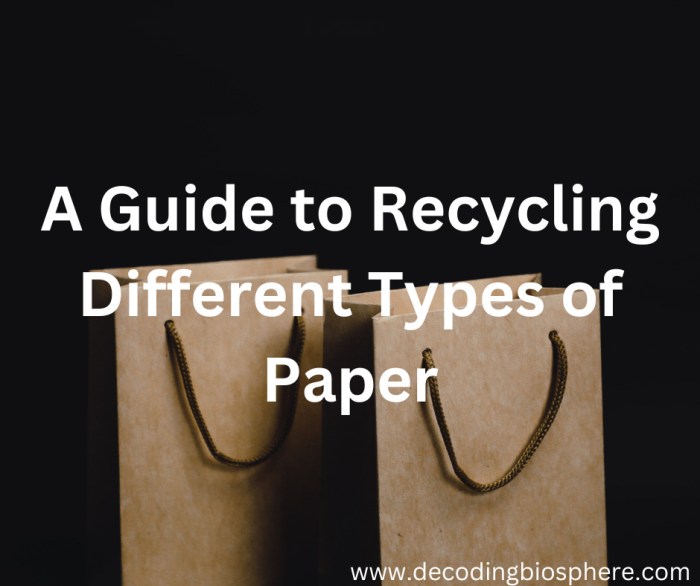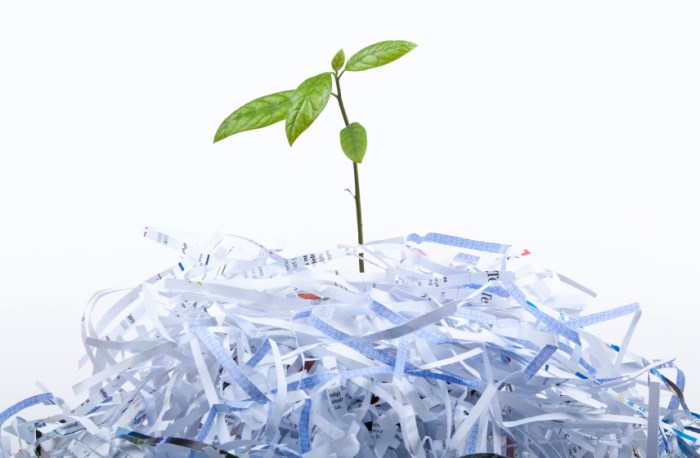Dive into the world of paper recycling with ‘4 Types of Paper and How to Recycle Them,’ exploring the nuances of different paper types and the eco-friendly practices of recycling.
Learn about the characteristics of various paper types, the importance of recycling, and practical tips for a greener future.
Types of Paper

Paper comes in various forms, each with unique characteristics and recycling processes. Understanding the differences between types of paper can help in proper recycling and reducing waste.
Newspaper
- Newspaper is typically made of low-grade paper with a high percentage of recycled content.
- Recycling newspaper involves de-inking and pulping the paper to create new newsprint.
- Common items made from recycled newspaper include more newspapers, egg cartons, and insulation materials.
Cardboard
- Cardboard is a thick and rigid paper material often used for packaging.
- Recycling cardboard requires breaking it down into fibers and creating new cardboard sheets.
- Common items made from recycled cardboard include new cardboard boxes, paperboard, and paper bags.
Office Paper
- Office paper is high-quality paper used for printing documents and other professional purposes.
- Recycling office paper involves de-inking and pulping to produce new office paper or tissue products.
- Common items made from recycled office paper include copy paper, tissue paper, and paper towels.
Magazines
- Magazine paper is glossy and coated, often used for colorful publications.
- Recycling magazines requires removing the coating, pulping the paper, and creating new magazine paper.
- Common items made from recycled magazines include new magazines, flyers, and brochures.
Importance of Paper Recycling

Recycling paper is crucial for the environment as it helps in conserving natural resources, reducing greenhouse gas emissions, and minimizing landfill waste.
Environmental Benefits of Recycling Paper
- Recycling paper saves trees, which are essential for absorbing carbon dioxide and producing oxygen. This, in turn, helps combat climate change and air pollution.
- It reduces water and energy consumption during the paper production process, leading to lower pollution levels in water bodies and decreased reliance on fossil fuels.
- By diverting paper from landfills, recycling helps in reducing methane emissions, a potent greenhouse gas that contributes to global warming.
Impact on Reducing Deforestation
- According to the Environmental Paper Network, recycling one ton of paper saves around 17 trees, 7,000 gallons of water, and 4,100 kilowatt-hours of electricity.
- Deforestation, caused by logging for paper production, leads to habitat loss, soil erosion, and disruption of ecosystems. Recycling paper helps in preserving forests and biodiversity.
Energy Savings Achieved Through Paper Recycling
- Recycling paper consumes considerably less energy compared to producing paper from raw materials. It saves around 60-70% of energy, reducing greenhouse gas emissions and reliance on non-renewable resources.
- According to the U.S. Environmental Protection Agency, recycling one ton of paper can save enough energy to power the average American home for six months.
How to Recycle Paper

Recycling paper is a simple yet effective way to reduce waste and help protect the environment. By following the proper steps and guidelines, you can make a significant impact on sustainability efforts.
Recycling Paper at Home
Recycling paper at home can be done by following these steps:
- Collect all paper waste, including newspapers, magazines, office paper, and cardboard.
- Remove any contaminants such as food residue or plastic inserts.
- Sort the paper by type and color to ensure proper recycling.
- Shred or tear the paper into small pieces to aid in the recycling process.
- Place the paper in a recycling bin or take it to a local recycling center.
Recycling Paper at a Recycling Facility
Recycling paper at a facility involves more advanced processes and equipment:
- The paper is sorted by type and quality using conveyor belts and sensors.
- It is then washed to remove ink and contaminants in a process called pulping.
- The pulp is screened and cleaned to remove any remaining impurities.
- Finally, the pulp is dried and rolled into new paper products.
Tips for Properly Recycling Paper
Here are some tips to ensure you are recycling paper effectively:
- Avoid mixing paper with other recyclables like glass or plastic.
- Check with your local recycling center for specific guidelines on paper recycling.
- Remove any wax-coated or laminated paper as they are not recyclable.
- Reuse paper whenever possible before recycling it to extend its lifespan.
Last Recap

In conclusion, embracing paper recycling not only benefits the environment but also plays a crucial role in conserving natural resources. Start your recycling journey today for a more sustainable tomorrow.